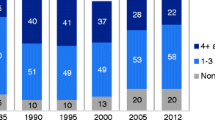Abstract
In the last few years there has been a tremendous expansion of legalized gambling in the midwest. Multiple forms of gambling are now easily accessible. The purpose of this study was to investigate the extent of gambling in a midwestern state and to assess differences in gambling attitudes and behavior between men and women, in various income groups, living in rural and urban areas. In addition, because of the rapid increase in gambling in this region, respondents were also asked their opinions about legalized gambling. Results indicated that gambling was pervasive in all segments of this midwestern sample; however, men spent more than women and urban residents wagered more than rural residents. The poor spent a greater proportion of their income on gambling than those with middle incomes. Both the gamblers, and many of the non-gamblers, would like to see more gambling opportunities in their communities as most view gambling as a benign recreational activity. One in every ten that gambled, however, did report family problems related to gambling.
Similar content being viewed by others
References
Clotfelter, C.T. & Cook, P.J. (1989).Selling hope: State lotteries in America. Princeton, NJ: Harvard University Press.
Commission on the Review of the National Policy towardGambling in America. (1976). Washington, D.C.: U.S. Government Printing Office.
Custer, R.L. (1982). An overview of compulsive gambling. In P. A. Carone, S.F. Yoles, S.N. Kieffer, L. Krinsky (Eds.).Addictive disorders update: Alcoholism, drug abuse, gambling (pp. 107–124). New York: Human Sciences Press.
Frankfort-Nachmias, C. & Nachmias, D. (1992).Research methods in the social sciences. New York: St. Martin's Press.
Franklin, J. & Thomas, S. (1989). Clinical observations of family members of compulsive gamblers. In H.J. Shaffer, S. Stein, B. Gambino and T. Cummings (Eds.),Compulsive gambling theory, research and practice. Lexington, MA: D.C. Heath.
Gaudia, R. (1987). Effects of compulsive gambling on the family.Social Work, 32, 254–256.
Hugick, L. (1989). Gambling on the rise, lotteries lead the way.Gallup reports, #285, 32–39.
Jacobs, D.F. (1989). Children of problem gamblers.Journal of Gambling Behavior, 5, 261–268.
Kaplan, H.R. (1989). State lotteries: Should the government be a player. In H.J. Shaffer, S. Stein, B. Gambino, & T. Cummings, (Eds.),Compulsive gambling: Theory, research and practice (pp. 187–204). Lexington, MA: D.C. Heath and Company.
Lesieur, H. R. & Blume, S.B. (1987). The South Oaks Gambling Screen (SOGS): A new instrument for the identification of pathological gamblers.American Journal of Psychiatry, 144, 1184–1188.
Lesieur, H. R., Cross, J., Frank, M., Welch, M., White, C., Rubenstein, G., Moseley, K. & Mark, M. (1991). Gambling and pathological gambling among university students.Addictive Behaviors, 16, 517–527.
Lesieur, H. & Rothschild, J. (1989). Children of Gamblers Anonymous members.Journal of Gambling Behavior, 5, 269–278.
Light, I. (1977). Numbers gambling among blacks: A financial institution.American Sociological Review, 42, 892–904.
Lindgren, H., Youngs, G., McDonald, T., Klenow, D., & Schriner, E. (1987). The impact of gender on gambling attitudes and behavior.Journal of Gambling Behavior, 3, 155–167.
Lorenz, V.C. (1990).Compulsive gambling hotline: Fiscal year 1990 final report. Baltimore, MD: National Center for Pathological Gambling, Inc.
Lorenz, V.C. (1987). Family dynamics of pathological gamblers. In T. Galski (Ed.),The Handbook of pathological gambling (pp. 71–88). Springfield, IL: Charles C. Thomas.
Nebraska Department of Health. (1991).Nebraska 1990: Vital statistics report. Lincoln, NE: Author.
Rosecrance, J. (1989). Controlled gambling: A promising future. In H.J. Shaffer, S. Stein, B. Gambino, & T. Cummings, (Eds.),Compulsive gambling: Theory, research and practice, (pp. 147–160). Lexington, KT: D.C. Heath and Company.
Suits, D.B. (1982). Gambling as a source of revenue. In H.E. Brazer & D.S. Laren (Eds.),Michigan's Fiscal and Economic Structure. Ann Arbor: University of Michigan Press.
Volberg, R. A. & Steadman, H.J. (1988). Refining the prevalence estimates of pathological gambling.American Journal of Psychiatry, 145, 502–505.
Author information
Authors and Affiliations
Rights and permissions
About this article
Cite this article
Abbott, D.A., Cramer, S.L. Gambling attitudes and participation: A midwestern survey. J Gambling Stud 9, 247–263 (1993). https://doi.org/10.1007/BF01015921
Issue Date:
DOI: https://doi.org/10.1007/BF01015921



